
Daphnephoria was a festival held every ninth year at Thebes in Boeotia in honour of Apollo Ismenius or Galaxius.

Daphnephoria was a festival held every ninth year at Thebes in Boeotia in honour of Apollo Ismenius or Galaxius.
The Daphnephoria consisted of a procession in which the chief figure was a boy of good family and noble appearance, whose father and mother must be alive. With young participants, the procession was able to combine components together, which signified an important stage or rite of passage. [1] Immediately in front of this boy, who was called the Daphnephoros ('laurel bearer'), walked one of his nearest relatives, carrying an olive branch hung with laurel and flowers and having on the upper end a bronze ball from which hung several smaller balls. Another smaller ball was placed on the middle of the branch or pole (which was called a κώπω), which was then twined round with purple ribbons, and at the lower end with saffron ribbons. These balls were said to indicate the sun, stars and moon, while the ribbons referred to the days of the year, being 365 in number. [2] The Daphnephoros, wearing a golden crown, or a wreath of laurel, richly dressed and partly holding the pole, was followed by a chorus of maidens carrying suppliant branches and singing a hymn to the god. [2]
The Daphnephoros dedicated a bronze tripod in the temple of Apollo, and Pausanias (ix. 10.4) mentions the tripod dedicated there by Amphitryon when his son Heracles had been Daphnephoros. The festival is described by Proclus, quoted by Photius in his Bibliotheca, codex 239. [2]
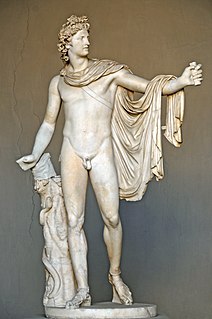
Apollo is one of the Olympian deities in classical Greek and Roman religion and Greek and Roman mythology. The national divinity of the Greeks, Apollo has been recognized as a god of archery, music and dance, truth and prophecy, healing and diseases, the Sun and light, poetry, and more. One of the most important and complex of the Greek gods, he is the son of Zeus and Leto, and the twin brother of Artemis, goddess of the hunt. Seen as the most beautiful god and the ideal of the kouros, Apollo is considered to be the most Greek of all the gods. Apollo is known in Greek-influenced Etruscan mythology as Apulu.

Delphi, in legend previously called Pytho (Πυθώ), in ancient times was a sacred precinct that served as the seat of Pythia, the major oracle who was consulted about important decisions throughout the ancient classical world. The oracle had origins in prehistory and it became international in character and also fostered sentiments of Greek nationality, even though the nation of Greece was centuries away from realization. The ancient Greeks considered the centre of the world to be in Delphi, marked by the stone monument known as the omphalos (navel). The sacred precinct of Ge or Gaia was in the region of Phocis, but its management had been taken away from the Phocians, who were trying to extort money from its visitors, and had been placed in the hands of an amphictyony, or committee of persons chosen mainly from Central Greece. According to the Suda, Delphi took its name from the Delphyne, the she-serpent (drakaina) who lived there and was killed by the god Apollo.

Pythia was the name of the high priestess of the Temple of Apollo at Delphi. She specifically served as its oracle and was known as the Oracle of Delphi. Her title was also historically glossed in English as the Pythoness.

Daphne, a minor figure in Greek mythology, is a naiad, a variety of female nymph associated with fountains, wells, springs, streams, brooks and other bodies of freshwater.
In Greek mythology, Eiresione or Iresione was the personification of an object very important in many Greek rituals and ceremonies: a branch of olive or laurel, covered with wool, fruits, cakes and olive flasks, dedicated to Apollo and carried about by singing boys during the festivals of Pyanopsia and Thargelia, and afterwards hung up at the house door. It could only be carried by children who had two living parents. The song they were singing during the ritual was also known as "eiresione":
Eiresione for us brings figs and bread of the richest,
brings us honey in pots and oil to rub off from the body,
Strong wine too in a beaker, that one may go to bed mellow.

A maypole is a tall wooden pole erected as a part of various European folk festivals, around which a maypole dance often takes place.

A sacrificial tripod, whose name comes from the Greek meaning "three-footed", is a three-legged piece of religious furniture used in offerings and other ritual procedures. This ritual role derives from its use as a simple support for a cooking vessel placed over a fire. As a seat or stand, the tripod is the most stable furniture construction for uneven ground, hence its use is universal and ancient.

A wreath is an assortment of flowers, leaves, fruits, twigs, or various materials that is constructed to form a circle.
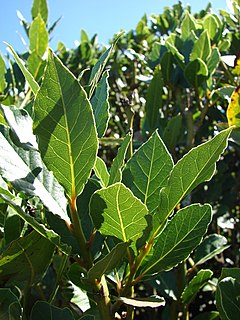
Laurus nobilis is an aromatic evergreen tree or large shrub with green, glabrous (smooth) leaves. It is in the flowering plant family Lauraceae. It is native to the Mediterranean region and is used as bay leaf for seasoning in cooking. Its common names include bay tree, bay laurel, sweet bay, true laurel, Grecian laurel, or simply laurel. Laurus nobilis figures prominently in classical Greco-Roman culture.
The Delphinia was a festival of Apollo Delphinius held annually on the 6th of the month Mounuchiōn (April/May) in ancient Athens.
Pyanopsia (Πυανόψια) or Pyanepsia (Πυανέψια) was an ancient Athenian festival held in honor of Apollo in Athens on the 7th day of the month Pyanepsion (October/November). Its name literally means "bean-stewing", in reference to one of the sacred offerings given during this time, and is taken from the Greek words πύανος - pyanos "bean" and ἕψειν - hepsein "to boil".
Thargelia was one of the chief Athenian festivals in honour of the Delian Apollo and Artemis, held on their birthdays, the 6th and 7th of the month Thargelion.

A laurel wreath is a round wreath made of connected branches and leaves of the bay laurel, an aromatic broadleaf evergreen, or later from spineless butcher's broom or cherry laurel. It is a symbol of triumph and is worn as a chaplet around the head, or as a garland around the neck.
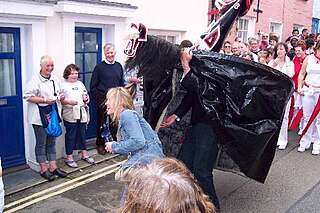
The 'Obby 'Oss festival is a folk custom that takes place each May Day in Padstow, a coastal town in North Cornwall. It involves two separate processions making their way around the town, each containing an eponymous hobby horse known as the 'Obby 'Oss.

The Temple of Apollo, god of music, harmony, light, healing, and oracles occupied the most important and prominent position in the Delphic Panhellenic Sanctuary. The edifice with the partially restored colonnade visible today dates to the 20th century BC and, according to ancient accounts, five different temples were built throughout history. The famous oracle, the Pythia, operated inside the temple, the location chosen, according to one tradition, due to a sacred chasm beneath the site emitting vapours, which were inhaled by the Pythia.
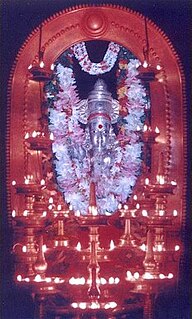
Manapullikavu is a Hindu temple located in Palakkad city, Kerala of India. The temple is most famous for the annual festival that takes place in the temple known as Manappullikavu Vela. Manapullikavu is also a major residential area in Palakkad city comprising apartments and residential colonies. Manappulikavu is ward 27 of Palakkad Municipality.

Delphi Archaeological museum is one of the principal museums of Greece and one of the most visited. It is operated by the Greek Ministry of Culture. Founded in 1903, it has been rearranged several times and houses the discoveries made at the Panhellenic sanctuary of Delphi, which date from the Late Helladic (Mycenean) period to the early Byzantine era.
A flower girl is a young female who scatters flower petals down the aisle during a wedding procession.
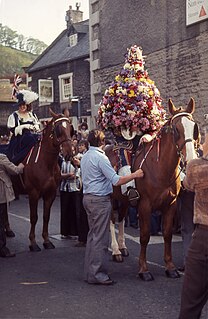
Castleton Garland Day or Garland King Day is held annually on 29 May in the town of Castleton in the Derbyshire Peak District. The Garland King, on horseback, and covered to the waist in a heavy, bell-shaped floral garland, leads a procession through the town.
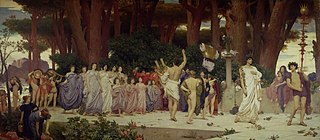
The Daphnephoria is an oil painting by Frederic Leighton, first exhibited in 1876.